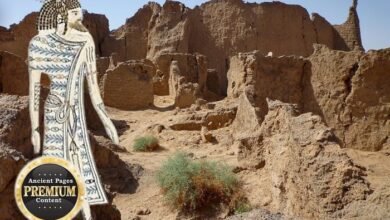
Conny Waters – AncientPages.com – Climate changes and crises have a profound impact on civilizations globally, making it essential to grasp their significance. An intriguing study conducted by scientists at the University of Southampton revealed insights into the magnitude and severity of the Late Antique Little Ice Age, a climate crisis from the 6th century that coincided with the fall of the Roman Empire.
In collaboration with researchers from Queen’s University Canada and the Chinese Academy of Sciences in Beijing, the team investigated unusual rocks on a raised beach terrace on Iceland’s west coast. Their research shows that these rocks were carried by icebergs during a short ice age that began around 540 AD and persisted for 200 to 300 years.
Historians have continually discussed the impact of climatic cooling on the decline of the Roman Empire. New research reinforces claims that this brief yet severe cooling phase likely exacerbated the empire’s decline, significantly influencing mass migrations that transformed Europe in this period.
“When it comes to the fall of the Roman Empire, this climate shift may have been the straw that broke the camel’s back,” said Tom Gernon , Professor of Earth Science at the University of Southampton and co-author of the new research in a press release.
The ice age is believed to have been initiated by volcanic ash resulting from three significant eruptions. This ash obstructed sunlight, decreasing global temperatures and creating conditions conducive to an ice age.
“We knew these rocks seemed somewhat out of place because the rock types are unlike anything found in Iceland today, but we didn’t know where they came from,” said Dr Christopher Spencer, Associate Professor at Queen’s University in Kingston, Ontario, and lead author of the research.
Study co-author Professor Ross Mitchell, from the Institute of Geology and Geophysics, Chinese Academy of Sciences (IGGCAS), said: “On one hand, you’re surprised to see anything but basalt in Iceland; but having seen them for the first time, you instantly suspect they arrived by iceberg from Greenland.”
Coastal Greenland, where the rocks analyzed in the study were pinpointed. Credit: Professor Ross Mitchell, The Institute of Geology and Geophysics, Chinese Academy of Sciences
Researchers determined their origin by examining the age and composition of tiny mineral crystals known as zircon embedded within rocks. They crushed the rocks into fragments and isolated hundreds of zircon crystals, many smaller than a pen tip. According to Dr. Spencer, zircons act as time capsules, preserving crucial information about when they crystallized and their compositional characteristics. This combination of age and chemical composition enables scientists to identify specific regions on Earth’s surface, similar to forensic techniques.
The research team discovered that the formation ages of these rock fragments spanned nearly three billion years, covering two-thirds of Earth’s history. They traced the rocky debris back to specific areas in Greenland, identifying a mosaic of ancient Earth’s crust fragments dating from approximately 0.5 billion to 3 billion years ago.
“This is the first direct evidence of icebergs carrying large Greenlandic cobbles to Iceland,” said Dr Spencer. Cobbles are rounded rocks about the size of a human fist.
“The fact that the rocks come from nearly all geological regions of Greenland provides evidence of their glacial origins,” added Professor Gernon. “As glaciers move, they erode the landscape, breaking up rocks from different areas and carrying them along, creating a chaotic and diverse mixture – some of which ends up stuck inside the ice.”
A collection of ancient rocks analyzed in the study has been traced to the geological provinces of Greenland. Credit: Dr Christopher Spencer, Queen’s University, Canada
The team determined that these ice-rafted rocks were likely deposited during the 7th century, coinciding with a major climate shift known as the Bond 1 event. The beach terraces rose as the land slowly rebounded after the last ice sheets melted.
Professor Gernon said: “This timing coincides with a known major episode of ice-rafting, where vast chunks of ice break away from glaciers, drift across the ocean, and eventually melt, scattering debris along distant shores.”
See also: More Archaeology News
Dr Spencer added: “What we’re seeing is a powerful example of how interconnected the climate system is. When glaciers grow, icebergs calve, ocean currents shift, and landscapes change. Climate-driven iceberg activity may have been one of the many cascading effects of rapid cooling.”
The study was published in the journal Geology
Written by Conny Waters – AncientPages.com Staff Writer







